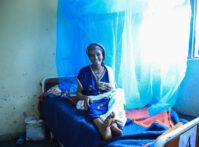-
Closing the Women’s Health Gap Report: Much Needed Recognition for Endometriosis and Menopause
February 14, 2024 By Sarah B. Barnes Women across the globe spend 25% more time in poor health and in varying degrees of disability than men, according to a new 2024 report by the World Economic Forum and the McKinsey Health Institute. Closing the Women’s Health Gap: A $1 Trillion Opportunity to Improve Lives and Economies addresses the root causes of the women’s health gap that if addressed could improve the lives of millions of women and potentially boost the global economy by $1 trillion annually by 2040.
Women across the globe spend 25% more time in poor health and in varying degrees of disability than men, according to a new 2024 report by the World Economic Forum and the McKinsey Health Institute. Closing the Women’s Health Gap: A $1 Trillion Opportunity to Improve Lives and Economies addresses the root causes of the women’s health gap that if addressed could improve the lives of millions of women and potentially boost the global economy by $1 trillion annually by 2040.
This article is based on the World Economic Forum and McKinsey Health Institute report, Closing the Women’s Health Gap: A $1 Trillion Opportunity to Improve Lives and Economies. All statistics come from this report unless otherwise hyperlinked.
Women across the globe spend 25% more time in poor health and in varying degrees of disability than men, according to a new 2024 report by the World Economic Forum and the McKinsey Health Institute. Closing the Women’s Health Gap: A $1 Trillion Opportunity to Improve Lives and Economies addresses the root causes of the women’s health gap that if addressed could improve the lives of millions of women and potentially boost the global economy by $1 trillion annually by 2040.
The new report also makes the business case for investment in women’s health. Closing the Women’s Health Gap demonstrates the economic potential of healthy women through empirical evidence and describes the tangible gains that industries could achieve through investments and innovations in women’s health.
Root Causes of the Gap in Women’s Health Attention
Gender inequality and sexism are at the core of the women’s health gap. When coupled with racism, classism, agism, ableism, heterosexism or other forms of oppression, the gap grows wider.
The report also describes four root causes of this gap that can best be addressed in this moment. Improved science will ensure a more complete understanding of women’s biology, as well as a better classification of women’s symptoms and manifestations of disease. Data shortages on health issues and symptoms particularly relevant to women must be filled and sex disaggregated data prioritized. Reduced barriers to care and enhanced quality of care for women should be targeted through increased education, improved accessibility and affordability, timely diagnosis, and choice of treatment.
And lastly, increased investments in women’s health research to ensure increased understanding, prevention, diagnostics, and treatment of women’s health conditions is also essential. According to the report, “Investing in women’s health shows positive return on investment: for every $1 invested, approximately $3 is projected in economic growth.”
A Business Case for Investments in Menopause and Endometriosis
Existing research on and innovations to address women’s health primarily focus on diseases with high mortality. Yet the authors add that diseases leading to disability, like menopause and endometriosis, which have an outsized impact on women’s quality of life, are often overlooked. More than 450 million women worldwide have menopause or peri-menopause symptoms, and some 190 million women are suffering from endometriosis. But the report observes that these women-specific conditions are under-researched, under-diagnosed, misunderstood, and under-prioritized. Investments in conditions like these, with a high unmet need, could lead to huge economic gains.
Investments in men’s health have already proven the business case. A prior McKinsey analysis found that in 2019-2023, funding for companies focusing on erectile disfunction (ED) was six times higher than that for endometriosis ($1.24 billion compared to $44 million). Furthermore, in 2022, the ED drug market was valued at $2.46 billion versus $1.22 million for endometriosis treatments. Menopause and peri-menopause symptoms affect even more of the population than ED and endometriosis (approximately 90% of all women experience menopausal symptoms), thus leaving an untapped market potential for medication of $120-$230 billion, globally, each year.
Healthy Women Spur Healthy Economies
According to the report, women of working age (20-64 years) bear nearly 50% of health burden affects. Endometriosis and menopause not only cause women pain and reduce their quality of life, but they can also substantially affect their ability to contribute to the paid economy.
Approximately 80% of women state that menopause interferes with their lives, and it has been linked to early departure from the paid workforce. Endometriosis is similarly linked to loss in productivity and absenteeism and for both conditions, prevalence and disease burden are heavily underestimated. Further attention and protections must be made in the workforce to retain and support women workers.
The authors of Closing the Women’s Health Gap say the case for action is clear: “Recognizing the vast potential to improve the lives and livelihoods of half the global population while boosting the economy serves as the catalyst for closing the women’s health gap.”
Sarah B. Barnes is the Director of the Maternal Health Initiative at the Wilson Center. She was also a member of the Coalition for Investing in Women’s Health that contributed to this report.
Sources: Grand View Research, McKinsey & Company, World Economic Forum, World Health Organization.
Photo Credit: Diverse women standing together. Julia Lazebnaya/Shutterstock.com.
 A Publication of the Stimson Center.
A Publication of the Stimson Center.







